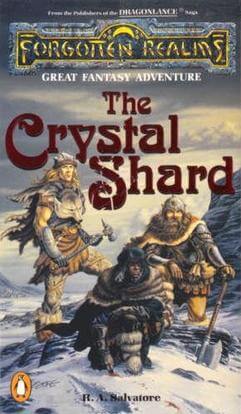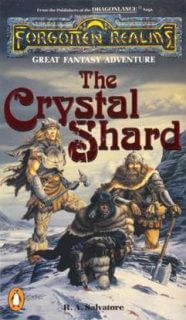(Forgotten Realms #2, The Icewind Dale Trilogy #1)
(First published 1988)
The bumbling wizard apprentice Akar Kessel is transformed into a tyrant when he discovers a millennia-old artefact of incredible power. Crenshinibon – the Crystal Shard – is a sentient relic that grants huge power to its wielder even as it bends them to its will. The frozen tundra soon shakes beneath the feet of the goblinoid army raised by Akar Kessel as he prepares to conquer the Ten Towns of Icewind Dale. Only a small band of heroes stands in his way: The strange drow, Drizzt Do’Urden, who has rejected the evil ways of his kind; the exiled dwarven king, Bruenor Battlehammer; and Bruenor’s indentured ward, Wulfgar, a mighty barbarian whom Bruenor spared in years past.
R. A. Salvatore’s debut novel, The Crystal Shard was originally intended to be set in the Moonshae Isles, before Salvatore discovered that the Forgotten Realms were in fact much larger than he had assumed. He then shifted the story a thousand miles north to Icewind Dale. Informed by his then-editor that they could not use one of his characters, Salvatore came up with the character Drizzt Do’Urden on the spot. These two decisions, seemingly arrived at by happenstance, would help establish Salvatore as a multiple New York Times bestselling author with over 20 million books sold. He is, by far, the top-selling Forgotten Realms author and has likely done more to establish the popularity of the setting than anyone besides Ed Greenwood.
It’s easy to be sniffy about The Crystal Shard. Some of the writing is clunky, as you might expect from a debut novel. The characters are largely archetypal and some of the plot developments are, upon a moment’s consideration, a little far-fetched even for a high fantasy novel. It’s what Salvatore does with these characters, the slight subversion he brings to the usual stereotypes, that fills them – and hence the story – with energy and pizzazz. This is helped in no small part by the excellent combat descriptions and Salvatore’s deep yet respectful borrowing of D&D lore. As with the first Realms novel, Darkwalker on Moonshae, the setting itself is also a star here. There’s a deep sense of hardship and loneliness on the frozen tundra of Icewind Dale. The isolated people of Ten Towns, the unforgiving nature of their fishing-based economies in the inhospitable cold – these create an air of desperation that wonderfully complements the story.
Drizzt is, of course, Salvatore’s (and the Realms’) most iconic creation – yet in The Crystal Shard he is a side character, something of an enigma whose true depths are only hinted at. Bruenor Battlehammer, the surly dwarf, is an unlikely friend and yet it’s because he is so unlikely we know that these characters have more going on than meets the eye. Bruenor’s interactions with Wulfgar are amusing but also, remarkably, occasionally touching. Torn between his loyalty to his barbarian people and the dwarf who taught him how to be a better man, Wulfgar’s coming-of-age arc is ultimately the heart of the novel. Yet there is so much else – from Drizzt’s mysterious past to the banishment of Bruenor’s clan to the hints of romance between Bruenor’s adoptive daughter Cattie-Brie and Wulfgar – that infuses the story with intrigue. Even the late mention of Artemis Entreri, who would himself become one of fantasy’s most infamous assassins, seizes the reader’s attention with an iron grip.
On the subject of Cattie-Brie, it’s unfortunate to note that she literally is the only female character in the entire novel – and her role in this one is fleeting at best. This is perhaps the most male-dominated fantasy novel I’ve ever read, or at least that I can remember reading. Of course, the author makes amends (and then some) with the fantastic Dark Elf Trilogy, still his crowning achievement. Just don’t come into this book looking for any kind of female representation. One thing I’d like to touch on is the graphic level of violence in The Crystal Shard. The body count runs to the thousands, with women and children ruthlessly cut down by goblinkin and monsters getting disemboweled, decapitated and gleefully slaughtered with a wild abandon that surprised even me, an author of “grimdark” fantasy! In one scene, Wulfgar literally crushes another man’s skull in his bare hands. I think it’s the contrast between the unshakeable belief of the heroes, and their ruthless use of violence, that is so disquieting. Unlike in most grimdark novels where everyone seems to accept or at least suspect they’re an utter bastard, Drizzt and co cleave, dice, and otherwise murder their enemies with utter conviction in their own righteousness. These are monsters – ergo, they deserve to die.
And ye gods, there are a lot of monsters in The Crystal Shard. D&D fans, particularly Dungeon Masters, will cackle with glee at the iconic nasties that show up only to be summarily dispatched by our heroes. Taking a leaf out of Darkwalker on Moonshae and its firbolg giants, R. A. Salvatore’s verbeeg are nine feet of cretinous stupidity who can seemingly kill themselves simply by getting out of bed awkwardly. Look beyond the verbeeg, though, and you have demons, dragons, hell hounds, and more goblinkin than you can shake a stick at.
All in all, The Crystal Shard is a novel in which everything somehow comes together, despite some occasional clumsiness. It packs an incredible amount of worldbuilding, action and – yes – even character development into its relatively short running time. More than this, it does an admirable job of setting the stage for the dozens of novels that would come after, many by the same author. It is, therefore, a resounding success by any measure. Essential reading for any Forgotten Realms fan – and recommended to anyone who likes bloody, action-driven fantasy.
**** out of *****


